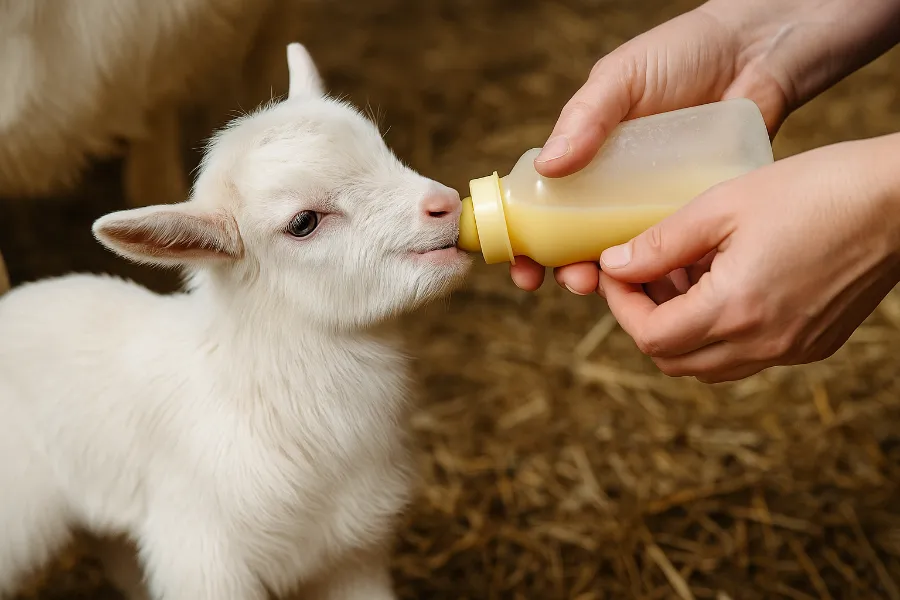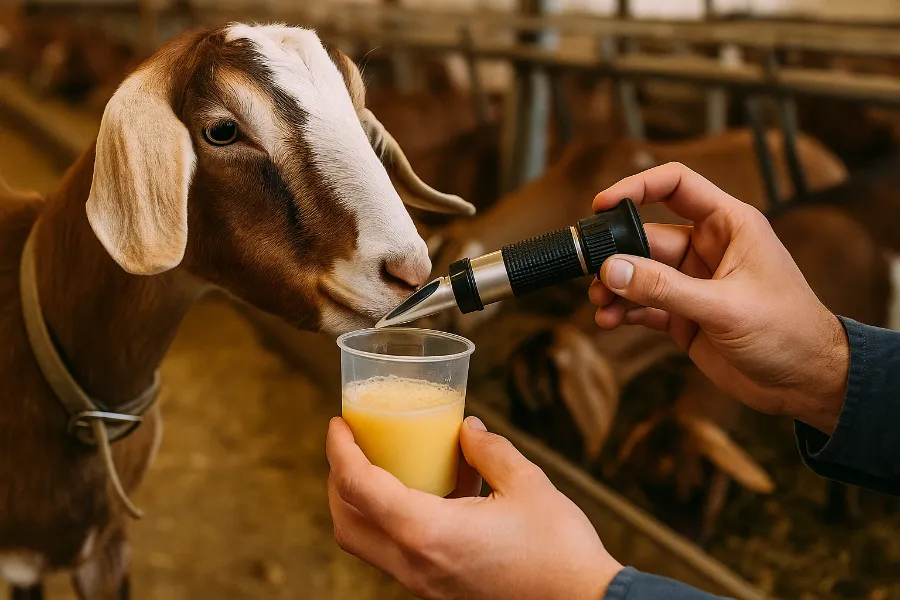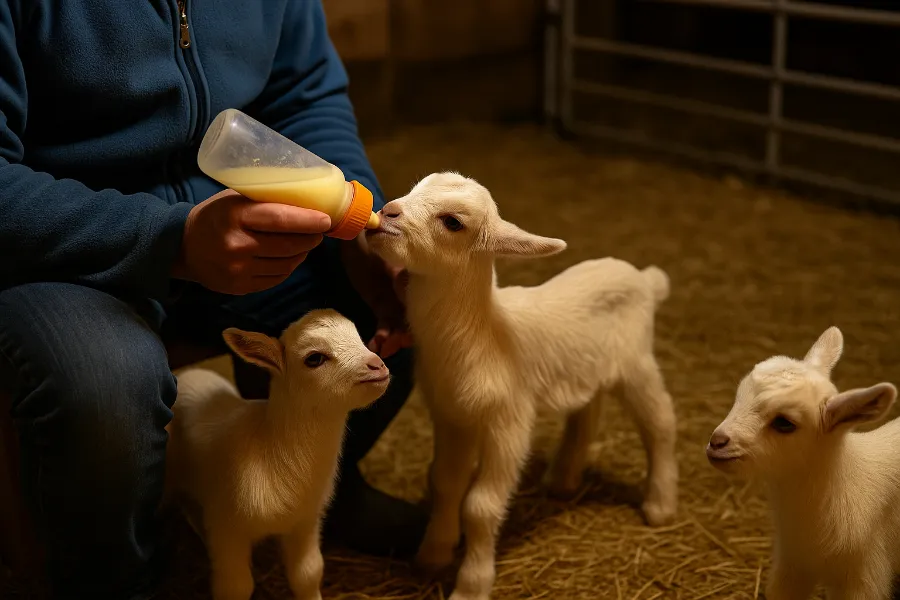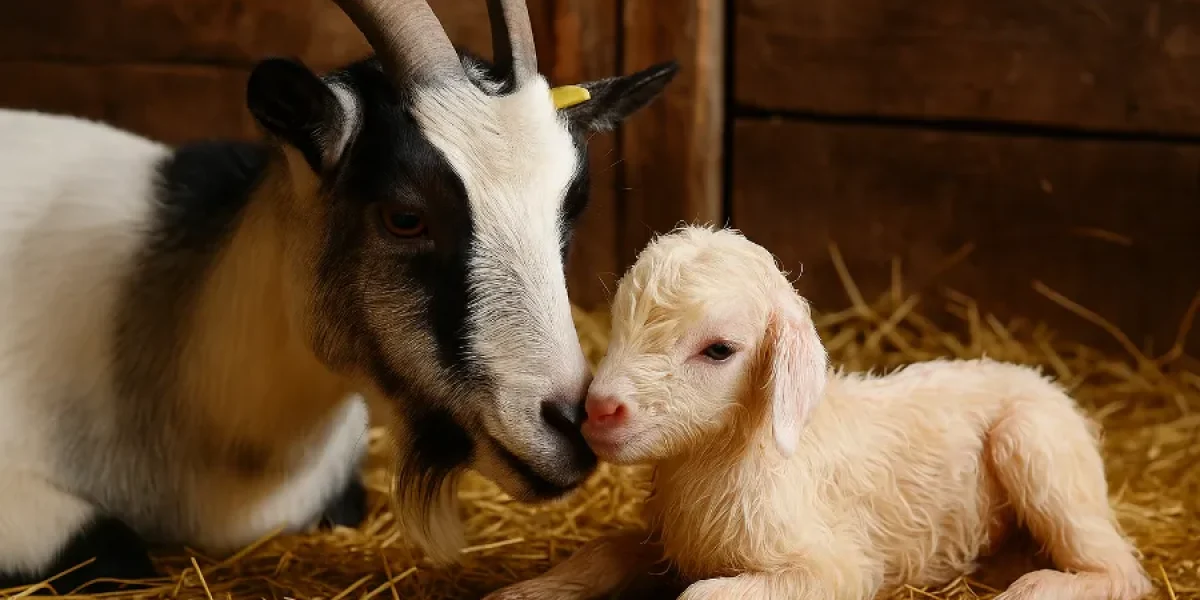I still remember that quiet night when my first doe kidded under the barn lights. The little kid slipped out, trembled, and I held it in my arms, whispering softly so it would try to find a teat. That very first sip of goat colostrum can mean life or death — because a newborn goat is born with no immunity. In that moment, I understood that everything I do in those first few hours matters.
In this post, I’ll share what I’ve learned about colostrum and how it fits into the foundation of newborn goat care. We’ll walk through goat feeding, feeding schedules, bottle feeding, direct nursing, clean milk, disease control, and how to balance homestead tradition with modern tools like a smart feeder or milk warmer. Over time, I’ve discovered that success with goats begins not with the milk you sell — but with the milk you never do.
Goat Feeding and Why Colostrum Changes Everything

No matter the breed or purpose of your herd, goat feeding starts with colostrum. The first milk isn’t just a source of nutrients; it’s an immune transfer, an energy booster, and the kid’s first line of defense against infection.
Goats don’t pass antibodies through the placenta, so kids are born with no immunity. They can only absorb antibodies from colostrum during the first 24 hours after birth — and absorption is strongest in the first 4 to 6 hours. That means every minute counts.
When I step into the barn during kidding season, I’m not just welcoming a new life — I’m racing the clock to make sure each kid gets its first feed as soon as possible.
Colostrum Benefits You Can See and Measure
Colostrum isn’t just milk; it’s medicine, nutrition, and protection all in one. I’ve seen its difference firsthand year after year, especially in kids that nurse right away.
Here are the main colostrum benefits every goat keeper should know:
- Immune Protection: Colostrum delivers antibodies (immunoglobulins) that protect newborns from diseases and infections.
- Energy Boost: It’s high in fat and protein, fueling the kid’s body heat and early movement.
- Gut Health: Colostrum coats and seals the intestinal lining, helping prevent harmful bacteria from entering.
- Cleansing Effect: It encourages the passage of meconium — the kid’s first waste — and jumpstarts the digestive system.
- Long-Term Strength: Kids that receive enough colostrum within one hour of birth are far more likely to thrive and resist illness later.
Every successful kidding I’ve had started with one simple rule: make sure that first drink happens, no matter what.
Newborn Goat Care: The First Hour After Birth

The first hour after goat birth is the most important window of a kid’s life. Here’s my go-to checklist for newborn goat care:
- Dry the kid immediately. Use clean towels to remove moisture and prevent chilling.
- Clear airways. Wipe the nose and mouth to ensure steady breathing.
- Dip the navel. Iodine or antiseptic spray prevents umbilical infections.
- Encourage nursing. The sooner the kid gets colostrum, the better.
- Check reflexes and body heat. If a kid can’t stand or suck within an hour, step in fast.
Weak kids, triplets, or those born in cold weather often can’t nurse on their own. That’s when I switch from watching to acting — using stored colostrum and a bottle to keep them alive and warm.
Feeding Schedule for the First 24 Hours
A clear feeding schedule helps ensure every kid gets enough colostrum, especially if you’re juggling multiple births. A general rule is to feed about 10–12% of the kid’s body weight in colostrum within the first 24 hours.
Here’s my go-to colostrum feeding plan:
| Time After Birth | Amount | Feeding Method | Notes |
|---|---|---|---|
| 0–1 Hour | 4 oz (120 mL) | Direct nursing or bottle | The critical first feed |
| 3–4 Hours | 4 oz | Bottle feeding | Stabilizes blood sugar |
| 8 Hours | 6 oz | Bottle | Builds immunity |
| 12 Hours | 6 oz | Bottle | Keeps energy consistent |
| 24 Hours | 8 oz | Nursing or bottle | Transition to milk feeding |
A small whiteboard in the kidding pen helps me track every kid’s feeding time and total intake. It may seem old-fashioned, but I can’t tell you how many problems it’s prevented. When you have multiple kids and tired eyes, a written plan keeps you from missing critical feedings.
Bottle Feeding: Your Lifeline When Nursing Fails

There’s nothing wrong with stepping in to help a kid nurse — sometimes, bottle feeding is the only way. I’ve had kids too weak to stand or does too exhausted to care for them. Knowing how to handle a bottle can make the difference between life and loss.
Bottle Feeding Tips:
- Use sanitized feeding bottles with small nipples that mimic the doe’s teat.
- Warm colostrum to 102–105°F before feeding — close to body temperature.
- Hold the kid upright and tilt the bottle downward, not upward.
- Always clean bottles and nipples after each use.
If you’re caring for multiple kids, mark each bottle with initials or color bands to keep feeding records clear. That simple step prevents confusion when one kid needs extra attention.
Direct Nursing: The Natural Approach
Whenever possible, I let kids feed directly from their mothers. Direct nursing is the natural way — and when it works, it’s the easiest and healthiest for everyone. The kid learns to bond, and the doe’s body releases oxytocin, helping her expel the placenta and let milk flow freely.
But even in a natural setup, it’s crucial to supervise. Make sure each kid:
- Finds the teat without trouble.
- Stays latched for at least several minutes.
- Has a warm belly afterward.
If you notice a weaker or smaller kid being pushed away, step in with a bottle to ensure everyone gets their fair share. A doe can only do so much at once — and as the keeper, it’s your job to balance things out.
Clean Milk and Disease Control
Even perfect timing won’t help if the colostrum is contaminated. That’s why clean milk and proper disease control practices are essential in every feeding routine.
I always:
- Milk into sanitized pails.
- Strain the colostrum before storage.
- Avoid pooling milk from different does unless I’m certain they’re disease-free.
- Pasteurize colostrum at 135°F for one hour if there’s any risk of CAE or Johne’s disease.
- Freeze colostrum immediately if not used within a few hours.
A clean start is a safe start. Every time I’ve gotten lazy about sanitizing, I’ve regretted it. Pathogens thrive in warm milk, and one contaminated feeding can infect multiple kids.
Milk Warmer and Bottle Warmer Essentials

Keeping colostrum at the right temperature is as important as feeding it on time. I use a milk warmer or bottle warmer to heat each batch evenly — not too hot, not too cold.
Best practices:
- Always heat colostrum in warm water, never directly on the stove.
- Target 102–105°F — roughly body temperature.
- Stir gently to avoid scalding or protein breakdown.
- If you’re in a pinch, use a thermos to keep milk warm between feedings.
Feeding cold milk can shock a newborn’s system, while overheated milk destroys antibodies. Temperature control is one of those small details that makes a big difference.
Smart Feeder Technology for Goat Farmers
Modern farming has brought amazing tools to small-scale goat keepers. A smart feeder automates bottle feeding, records intake, and monitors feeding times. In large dairy goat operations, these devices can identify kids by microchip and adjust feeding amounts individually.
I’ve used both approaches: my old reliable bottles and an automatic feeder during kidding peaks. While technology is convenient, I never let it replace observation. Machines don’t see the kid that’s shivering in the corner or struggling to latch. But they do make it easier to manage more kids with precision and consistency.
For homesteads raising a dozen or more kids per season, investing in a feeder can save hours of manual work — as long as you still walk through the pen and check every little face.
Feeding Time and Hourly Schedule Consistency
Consistency is everything in newborn goat care. Colostrum feeding should follow an hourly schedule in those first 24 hours. Even a one-hour delay can reduce how much immunity a kid absorbs.
Here’s what I’ve learned:
- Set alarms for every scheduled feeding.
- Keep a log with time, quantity, and method.
- Avoid skipping or combining feedings.
Kids thrive on predictability. The steadier your rhythm, the stronger they grow. On nights when multiple does kid at once, I stay up with a warm mug of coffee, cycling between pens and bottles, knowing each one is getting exactly what it needs.
Homestead Farming: Blending Heart and Routine
Homestead life has taught me that good farming blends both tradition and practicality. On my small property, I use the tools I trust, but I still rely on my instincts first.
In true homestead farming fashion:
- I dry every kid by hand.
- I log feedings on a whiteboard instead of an app.
- I warm bottles in a pot of water on the stove.
- I save and label extra colostrum in the freezer for emergencies.
It’s a mix of old and new — one that honors the rhythm of the barn while keeping up with the science that keeps goats healthy. Whether you’re raising five goats or fifty, the principles stay the same: warmth, timing, cleanliness, and care.
Dairy Goats and Colostrum Quality
For dairy goats, the quality of colostrum determines the future of your herd. Testing it with a refractometer helps ensure it’s rich in antibodies. A reading above 22% indicates strong immunity.
I always collect and freeze only the first day’s colostrum — the golden milk that truly counts. By day two, antibody levels drop dramatically. Label each batch with the doe’s name, date, and quality reading, and rotate your frozen stock every season.
This habit not only protects your kids but also adds value to your herd, especially if you sell registered dairy stock. Buyers love knowing your goats are raised with meticulous health care right from the start.
Final Thoughts: The First Milk That Builds the Future
When people ask me the single most important lesson I’ve learned in goat farming, I don’t hesitate: it’s all about goat colostrum.
Every successful kidding, every healthy doe, and every thriving herd begins with that thick, golden milk. It’s the bridge between birth and life — between hope and strength. Whether you use bottle feeding, direct nursing, or a smart feeder, what matters most is that every kid gets enough, early, and clean.
Feed within the first hour. Keep milk warm and safe. Track your feeding schedule like clockwork. And above all, remember that while technology helps, it’s your presence, care, and instinct that truly make the difference.
In the end, goat farming isn’t just about milk yields or market prices — it’s about nurturing life from the very first drop.
FAQs
Goat colostrum is the thick, antibody-rich first milk produced right after birth. It provides essential immunity, energy, and nutrients that help newborn kids survive and grow strong.
Kids should receive goat colostrum within the first hour after birth. Early feeding ensures they absorb antibodies effectively before their gut closes within 24 hours.
A healthy guideline is 10–12% of the kid’s body weight in colostrum within the first 24 hours. Feed smaller portions every few hours to support digestion and energy.
Yes, you can freeze extra colostrum in labeled portions and thaw it gently in warm water. Avoid microwaving, as high heat destroys antibodies and reduces its benefits.
Direct nursing allows natural bonding and helps the doe’s milk flow, while bottle feeding ensures precise amounts and disease control. Many farmers use both for best results.
Always collect it in sanitized containers, strain to remove debris, and store it quickly. Pasteurize if needed to prevent diseases like CAE or Johne’s.
Use a bottle warmer or milk warmer to maintain ideal temperature and a refractometer to test quality. Larger herds may benefit from a smart feeder for accurate, timed feedings.













